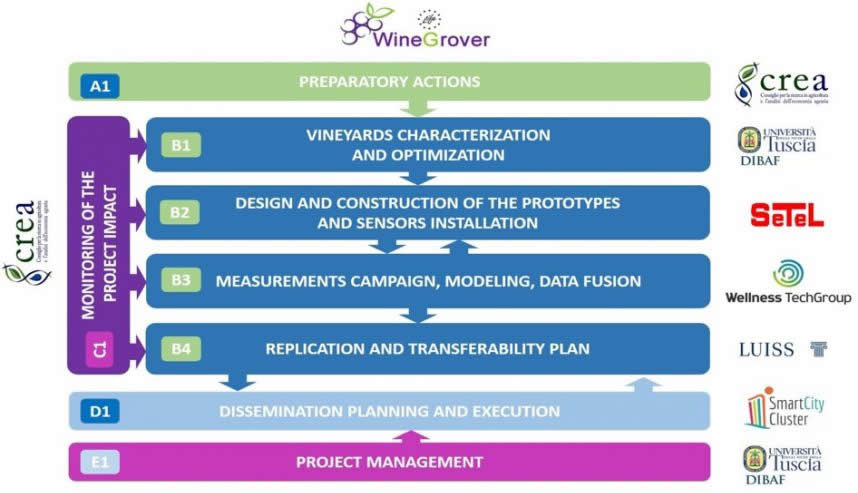The project will be implemented in the following actions in 38 months:
A1. Preparatory Actions M1-M2
The project will start on September 2020. Preparatory actions will include the definition of the technical protocol for implementing the system as applicable to the selected vineyards and the protocol to measure emissions and quantify the reduction of pesticides, water and nutrients. No permits will be required for the use of the proposed technologies.
B1. Vineyards characterization and optimization M3-M7
The two vineyards will be characterized through the observation of the specific performance and attributes of vines. Experimental data already collected in previous projects will be interpreted leading to targeted management of inputs and selective harvesting at vintage. Distinct homogenous management zones for vine performances will be defined for each field allowing to know the vineyard variability at vines detailed levels and to adopt targeted management reducing timing and rate of application of water, fertiliser or spray, or the use of machinery and labour for operations such as harvesting, pruning and any other aspect of vineyard management.
B2. Design and construction of the prototypes and sensors installation
Two similar prototypes (consisting of an innovative autonomous terrestrial rover and actuators and a commercially available remote-controlled aircraft, equipped with multi- sensory instrumentation), will be assembled to be adapted to the two vineyards. The prototypes will be used to carry out measurement campaigns in the two vineyards in B.3. Prototype1 will be assembled from M3 to M6 and will be used from M7 to M13 on the Italian vineyard for the overall period of the production and harvesting seasons until 2023. From M5 to M7, a series of sensors for getting real time data and for the ground monitoring of the main microclimatic parameters, a real
time location system, and a ground control IoT platform will be installed on the vineyard in Italy. Prototype 2 will be assembled in year 2 (from M15 to M18) and it will be used until the end of the project in the vineyard in Spain where sensors will be also installed from M17 to M19.
B.3 Measurement campaign, modeling, data fusion
First measurement season campaign will start in Italy on M7. Vegetative parameters will be monitored in order to allow standardization of methodology and outputs. In the following years, measurement campaign will be implemented also in the Spanish vineyard, under different management practises and climate conditions to calibrate and standardize the methodology. The integration of several noninvasive sensing technologies (chlorophyll-based fluorescence, RGB machine vision, IR thermography) and navigation (GPS) techniques will allow to obtain large amounts of agronomical and physiological data from the vineyards. This data will be fused and integrated with algorithms, calibration curves and models that will process acquired information for their further implementation. From year 2, two prototypes will be operating among the two vineyards and prototype 1 will be used in Italy for initial experimentation of foliar drip irrigation and pesticides and nutrients precision application. On year 3 the two prototypes will be fully operational for both monitoring and application of pesticides and nutrients and for irrigation. The results of optimized pesticides, variable rate nutrients and water application in the selected management zones during 3 growing seasons will be compared to the conventional practice.
B4. Replication and Transferability Plan
The analysis of the results of B.3 will help to define protocols to improve the exploitation strategies of precision viticulture. This data will be used for the replication plan and they will be elaborated to transfer the project results to other EU vineyards. An exploitation plan and a business plan will be defined.
C1. Monitoring of the project impact
This action will include the monitoring of:
1) LIFE key project level indicators.
2) The environmental impact of the project through LCA.
3) The socio-economic impact of the project.
D1. Dissemination planning and execution
The consortium will:
1) Define a Dissemination Plan to identify the main target audiences, key messages and communication channels.
2) Develop communication tools and materials (notice boards, website, brochures, scientific papers, Layman’s report).
3) Attend and organize dissemination events (conferences, meetings, workshops, final event with policy makers).
4) Network with other projects and stakeholders.
E1. Project management (M1-M38)
The CB has experience in other LIFE and EU projects and is in charge of the project management. This action will include: the definition of the consortium operating procedures, the day-to-day management,
the organization of consortium meetings, and the preparation of the After-LIFE Plan, use of green procurement and eco-labelling schemes. This action involves the participation of all partners.
